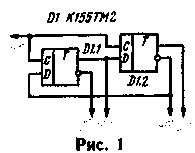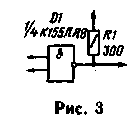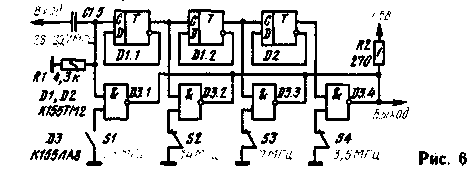
|
|
ENCYCLOPEDIA OF RADIO ELECTRONICS AND ELECTRICAL ENGINEERING Digital microcircuits in sports equipment. Encyclopedia of radio electronics and electrical engineering
Encyclopedia of radio electronics and electrical engineering / Nodes of amateur radio equipment Recently, radio athletes - shortwave, ultrashortwave and "fox hunters" - are increasingly using integrated circuits in their equipment. Now on microcircuits it is possible to perform almost the entire receiving and most of the transmitting path of the transceiver, to make a radio receiver for "fox hunting". The use of microchips not only significantly simplifies the design of sports equipment, reduces its size and weight. There is a real opportunity to create a qualitatively new equipment, the manufacture of which from discrete elements, in essence, was inaccessible to a wide range of radio amateurs. Digital scales, high-quality phase-locked loop systems, display devices (displays) - this is not a complete list of nodes, the introduction of which into sports equipment became possible only thanks to the use of integrated circuits. In sports HF and VHF equipment, digital microcircuits are increasingly being used. Of these, in amateur radio practice, the most widely used microcircuits are the K133 and K 155 series, which have a fairly high speed, good load capacity, and are easily consistent with nodes made on transistors. These microcircuits are used for automatic telegraph keys, Morse code sensors, electronic digital scales, individual units of sports equipment, etc. Using D-flip-flops, it is easy, for example, to build a phase shifter with a phase shift of 0°-180°-90°-270° (Fig. 1). Compared to that described in "Radio", 1977, No. 6, it provides a higher accuracy of phase relationships, since it does not have a pre-division trigger that introduces an additional error.
On fig. Figure 2 shows a diagram of a mixer on a D-trigger, which compares favorably with analog ones not only in its simplicity, but also in the fact that no conversion "products" are formed at its output, except for the difference frequency and its harmonics. This allows, in some cases, to abandon the filter system. Signals with frequencies f1 and f2 are fed to inputs D and C. The distribution of signals over the inputs does not matter: in any case, a difference frequency signal will appear at the trigger outputs. It is only important that, firstly, the signal at input C has a sufficiently steep edge, and secondly, that the frequencies f1 and f2 differ from each other by no more than 30...35%. The shape of the signal at the input D does not play a special role. On the basis of such a mixer, it is possible to build an effective threshold detector for the fox receiver. The telegraph local oscillator signal is fed to input C, and the IF signal is fed to input D. Until the positive half-wave of the IF voltage reaches the level of 2 ... 2,4 V, there will be no signal at the output of the detector. Such a detector has a pronounced limitation threshold and is very effective in short-range searches. If the intermediate frequency in the fox receiver is less than 1 MHz, it is more expedient to use economical triggers of the K134 series. Logic elements can also be used to build analog mixers, with which you can get both the difference and the sum frequency of two oscillations. One of the variants of the mixer on the element "2I-NOT" is shown in fig. 3. In principle, it is no different from the usual ones made on analog elements. The ratio of frequencies here can be any, and the signal of the difference or sum frequency from the spectrum of the output signal is selected by the appropriate filter. The digital and analog mixers described above are not suitable for building SSB detectors, modulators and converters. However, linear mixers can also be created using digital chips.
One of the variants of such a mixer (proposed by V. Polyakov, RA3AAE) is shown in fig. 4. It is a balanced modulator based on a key converter and can be used to build single-sideband signal conditioners or converters. The modulator does not need to be adjusted. When using a matching transformer (T1) from a transistor radio, the carrier frequency is suppressed by at least 40 dB. For greater suppression, it is necessary to carefully symmetrically balance the secondary windings of the transformer. Strictly speaking, in such a modulator, the carrier frequency signal should not be present at the output at all, since it does not go to the transformer, but only determines the switching frequency of electronic switches made on elements D2.1 and D2.2, which connect the outputs of the secondary windings to common wire.
However, in a real device, due to the insufficient symmetry of the secondary windings of the transformer, the output always has a carrier frequency voltage. Digital circuits can be used to drive the output stages of low-power telegraph transmitters, such as "fox hunting" transmitters (Fig. 5). Such an output stage operates in a mode close to class B. Essentially, the transistor V1 is excited by rectangular pulses close to a meander in shape, therefore, sufficiently effective harmonic filtering must be applied at the transmitter output. At a frequency of 3,5 MHz, the input power can be 10 ... 12 watts. Resistor R2 is selected so that it does not exceed the maximum allowable value for transistor V1. In amateur shortwave equipment, the method of multiplying the frequency of a low-frequency master oscillator is often used to obtain frequencies in higher frequency ranges. In this case, the device turns out to be bulky and critical to setup. In addition, as the harmonic number increases, the signal amplitude decreases. Much easier this problem can be solved by dividing the frequency of the master oscillator, using elements of digital technology (Fig. 6). On the triggers D1, D2.1, a frequency divider is assembled, on the D3 chip - electronic keys. Depending on the specific conditions, the master oscillator can be smooth, quartz, interpolated, or covered by a PLL loop.
Please note that the frequencies corresponding to the ten-meter amateur band exceed the switching frequency limit guaranteed for the K155 series triggers. Therefore, not every K155TM2 chip will work in the first stage of the divider. Similarly, not every K155LA8 chip will efficiently pass these frequencies. Therefore, when repeating this device, it may be necessary to match D1 and D3. As an example of a radio transmitting device that uses digital microcircuits, one can cite a transmitter for "hunting foxes" developed by R. Guev (UA6XBP) and A. Volchenko. It was exhibited at the 28th All-Union exhibition of radio amateurs - designers DOSAAF. The transmitter circuit is shown in fig. 7. Its output power is about 3,5W in 2MHz band, and about 28W in 1,5MHz band. In the range of 28 MHz, the signal of the master oscillator, made on the transistor V1, through the elements D1.1 and D1.2 is fed to the power amplifier on the transistor V2 and then to the antenna. Switch S1, if necessary, includes a tone generator (elements D1.3. D1.4, D2.1), a signal with a frequency of about 1000 Hz from which is fed to the second input of element D1.1, which in this case acts as an amplitude modulator.
When operating in the range of 3,5 MHz, the passage of the signal through the element D1.1 is blocked by a logical 0 coming through the contacts of the switch S2 to the lower (according to the circuit) input of this element. The master oscillator signal is divided by triggers D3.1, D3.2, D4.1 by 8 and from the output of the last trigger is fed to a power amplifier made on transistor V3. Manipulation can be carried out both with the help of a telegraph key and with an automatic manipulator. Coil L1 in the transmitter is made on a ring core made of M30VCh ferrite (size K12X X6X4.5). It contains 13 turns of PELSHO 0,35 wire (outputs from the 3rd and 6th turns, counting from above according to the diagram). Coils L2-L4 are wound on a frame with a diameter of 10 mm. Coil L2 should contain 15 turns of PEV-1 0,8 wire, L3 (wound over L2) - 6 turns of PELSHO 0,35, L4 - 40 turns of PELSHO 0,15. For coils L2 and L4, taps should be made from about a third of the turns (counting from the top according to the diagram). Trimmers for coils L2-L4 - SCR-1. Author: T. Krymshamkhalov (UA6XAC), Nalchik; Publication: N. Bolshakov, rf.atnn.ru
Artificial leather for touch emulation
15.04.2024 Petgugu Global cat litter
15.04.2024 The attractiveness of caring men
14.04.2024
▪ Bristlecone 72 qubit quantum processor ▪ Yaogan-30-09 Remote Sensing Satellites
▪ section of the Electrician website. Article selection ▪ article Scanning probe microscope. History of invention and production ▪ article How many species are modern elephants divided into? Detailed answer ▪ article Working with a kerosene burner. Standard instruction on labor protection ▪ article Riddles about clouds, thunder and lightning
Home page | Library | Articles | Website map | Site Reviews www.diagram.com.ua |






 Arabic
Arabic Bengali
Bengali Chinese
Chinese English
English French
French German
German Hebrew
Hebrew Hindi
Hindi Italian
Italian Japanese
Japanese Korean
Korean Malay
Malay Polish
Polish Portuguese
Portuguese Spanish
Spanish Turkish
Turkish Ukrainian
Ukrainian Vietnamese
Vietnamese







 Leave your comment on this article:
Leave your comment on this article: